Traditional JRPG, with beat-um-up style random encounters
Much hyped by people in the know, Tales of Symphonia came out in the US a few months ago, and after the usual annoying 6 month wait will be getting a PAL release this Friday.
It's been universally praised by reviewers, except Penny Arcade, where Tycho called it "compressed hell".
But what exactly is it, and why is it so loved?
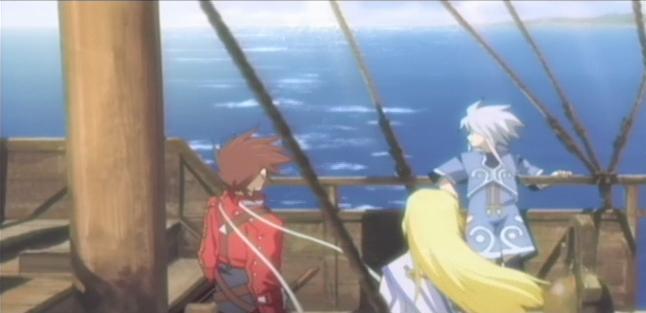
Fmv prettiness from the intro
In one sentence, it's probably the most traditional Japanese RPG you can have, but it's done really, really well. There is much more to it than that, but that's it's main strength.
You start off with Llyod, typical RPG hero. Then you have his girlfriend, Colette, who we are told straight from the start is the chosen one, and must go around the land releasing elemental seals to save the world. Then you have his best friend, Genis the spell-caster. The game starts off so much like a textbook RPG, it can almost make you wince, but just when you think you have it figured, it suddenly does something different. Most of the plot you can see coming, however this makes it all the better when a big twist takes you by surprise.
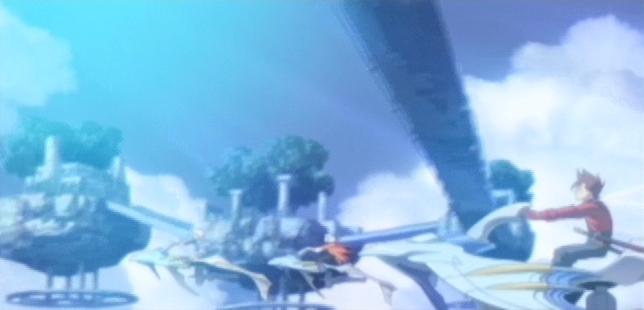
More fmv prettiness
It's hard to explain why something that isn't very original is so good. Certainly, if you didn't like Golden Sun, Grandia, or any other similar game, then you won't like this one either. But, if you like RPGs, you will just find everything done so well. You've met your initial bunch of team members countless times before in other games. But then Tales suddenly turns the unoriginality into an advantage - much like watching the second series of a sit-com where you already know the characters by now, you understand their personalities and so you better understand the jokes and quips.
Oh, and it is unlikely to make you laugh out load, but many of the conversations are quite amusing. Tales has an interesting feature, where you can listen to the characters talk amongst themselves and discuss the latest turn of events. In most RPGs we assume they talk, discus tactics, and get to know each other behind the scenes where we don't see, however Tales actually shows you with optional scenes. These play out like a cross in between the codec of Metal Gear Solid (although nowhere near as annoying) and the campfire talks of some other games. Their purposes can be character building, revealing some more information about the characters talking, or they could be the party discussing how to solve a particular problem they are facing, discussing what the latest turn of events means, or finally just a comedy sketch. There is about a thousand in total, although you're only likely to see about a couple of hundred depending on where you go, what you do, and which choices you make during the game.
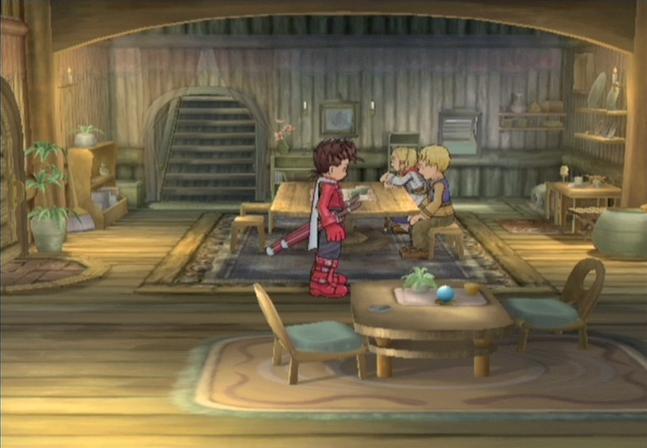
Here's an ingame shot. The backgrounds are normal 3D, if with cartoonish textures, while cell shading is used for the characters. It looks very cool
The graphics are amazing. It doesn't use sprites, it's all cell shading, and it looks amazing. With the possible exception of Wind Waker, this is the best cell shading that I've ever seen. And it's not one of those games where the cell shading doesn't suit it - trust me, when you first start it will take you by surprise, if only just a little bit, how good it all looks.
I don't usually mention the fmv under graphics, but I think it does deserve a special note here. When there is fmv (it's only used when something really, really huge happens, the game doesn't rely on it for most of the time) it looks amazing. A mixture of cell shading, hand drawn drawn backgrounds, and hand drawn characters is used, to stunning effect.
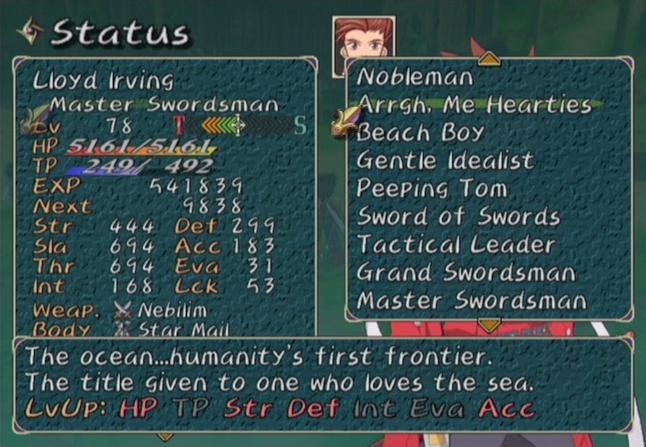
Excuse me if I add in a paragraph explaining the titles. Titles are earnt much like bonuses in Smash Bros. Some are got as the game progresses, whilst some are earnt by doing random silly things. You can pick one of the titles that each character has earnt to use. Which they have equipped determines how they level up, and in some cases changes their costume
Anyway, enough about the presentation, how does it play? If you've played any traditional Japanese RPG, then you'll be familiar with most of the gameplay on the field. You have an overworld map which you walk around (and eventually get an airship). Connected to it are towns and dungeons, which you visit and revisit according to the plot. The dungeons aren't all walk from A to B avoiding monsters (thank god!), most involve solving puzzles to reach the end. The puzzles start simple, and progress to you having to think a little bit as the game goes on. Nothing to taxing, but better than most efforts.
But the whole thing is rather spoilt by a few dungeons near the end, where you just have a long walk from the start to the finish with monsters in the way. These feel rather cheap and frustrating.
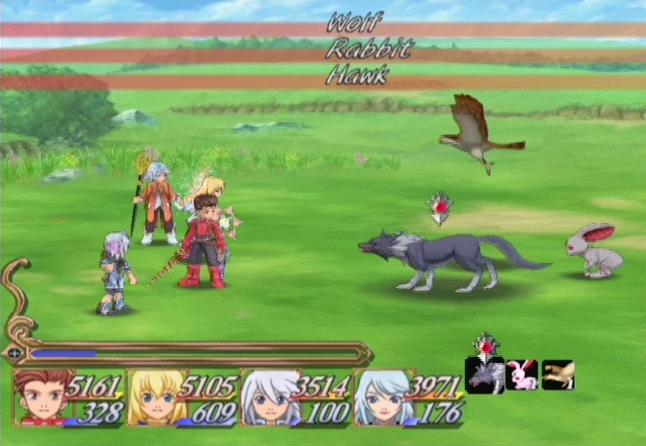
A wolf, a hawk, and a cute little bunny rabbit face up against my high level characters. Not too hard to picture what's going to happen next...
The battles I think will take some explaining. But I can give you a rough idea by saying that it's Grandia crossed with Guilty Gear.
Monsters show up on the field, and you fight them by walking into them. There's no first strike, but you can still be back attacked. You have up to 4 characters in your team (4 being the max, but there are a few times in the plot when you don't have 4 party members to reach that). Unless you have friends sitting next to you who want to play for the fights, one of your characters will be played by you, and the rest will be played by the AI.
You'll generally have more fun if you control a fighter, and let the AI get on with the more boring, less skilful tasks of spell casting and healing, so to that end the game starts you off with the main character, Llyod, who has no spells and is just melee, to be the player controled character.
The combat itself plays out like a 2D fighter. You can back off or get closer to your foe (x axis), and you can jump/knock your enemy in the air (y axis). You have a standard combo attack (various different combos can be start, depending on the direction the analogue stick is pressed at the time, just like in Smash Bros.), various special moves (again, set up just like Smash Bros., only you can pick which moves go to which direction), block and jump. The only complication is that the battlefield is actually 3D, and you are forever stuck on the same plane as your enemy until you switch targets. (Annoyingly there is no free move button.)
But lurking under all of that is a Grandia like interface. At any time you can pause the game, and issue orders to your team, just like in a normal RPG. The clever bit is, that you don't have to do this unless you get annoyed with the way the AI is behaving, and it is all invisible if you want it to be.
On top of all that, Tales has another trick up it's sleeve. If you have a friend, they can take control of another of your team instead, making it a 2 to 4 player game. Whole new ways of fighting open up when playing with more than one person, mostly because every character in the game plays differently, so your role and options open will be different depending on the character you pick.

But which did we find first..?
Just before I end this, I want to talk about a few more problems that need mentioning before anyone trots off and buys this game.
Unfortunately, the mutliplayer side to the game seems to be just an after thought, and is riddled with problems.
For a start, it's only for the battles. It would have been nice to have the other players appear on the field as well or something, but as it is they are just watching until a fight happens.
Every time you change players, every time you want to use a new technique or charge your techs, and every time the plot changes which characters you have, you must redo the settings for everyone. This isn't much of a problem when playing with just one person, because Lloyd is always in the party and you typically always play as him. (Although the game did piss me off by deleting my healing shortcut every time the healer left the party for 5 minutes.) But with multiple players waiting as player one re-does their controls each time, it gets annoying.
Another annoying thing is that the camera always follows player one. The other players often find themselves blind and off-screen.
Oh, and every time someone pauses the game to issue an order or change their target, it pauses the game for everyone. No biggy if you get used to the sudden pause, but it is annoying.

Zelos. You get him about half way through the game. You're either going to find him annoying, or he's going to crack you up. Personally, I was laughing every time he said anything
I've said that the plot can be a bit predictable at times, and unfortunately it falls foul of another common mistake of RPGs - mumbo-jumbo physics. A good story ought to make sense and avoid contradictions. However, in Tales, there are many places where the plot revolves around the effects of various magical bounds/curses/items. The authors just make this shit up as they go along, meaning that in many places the story takes what is essentially a random direction without sense. And unfortunately the ending of the game is one of these places, making it totally unsatisfying.
But that's pretty much it for the bad things. And there are so many things that I've not mentioned yet, such as the titles/awards, the way the plot unfolds differently in some places depending on how you play and what choices you make, and all of the other little touches that make this game so good. But, you'll find them out for yourself. This is a very good RPG, and deserves to be played by any RPG fan. That it's a Gamecube exclusive in the west may be annoying for some playstation owning RPG fans, but the ps2 can't have all the breaks - this is a very strong RPG in the Gamecube line up, and along with Paper Mario, Zelda and PSO definitely makes the GC worth picking up for it.
9 out of 10 says me.